Role of Traditional Ecological Knowledge and Seasonal Calendars in the Context of Climate Change: A Case Study from China
Abstract
1. Introduction
2. Materials and Methods
2.1. Study Area
2.2. Sampling Sites
2.3. Data Collection
2.4. Data Analysis
3. Results
3.1. Temperature and Precipitation Trends
3.2. Indicators and Seasonal Activities
3.2.1. Transhumance Activities
3.2.2. Seasonal Cropping
3.3. Climate and Farming
3.3.1. Growing Degree Days (GDD)
3.3.2. Standardized Precipitation Index (SPI)
4. Discussion
4.1. TEK Based Observations
4.2. Role of TEK in Annual Activities
4.3. Role of TEK in the Context of Climate Change
4.4. Future Perspective
5. Conclusions
Author Contributions
Funding
Acknowledgments
Conflicts of Interest
Appendix A
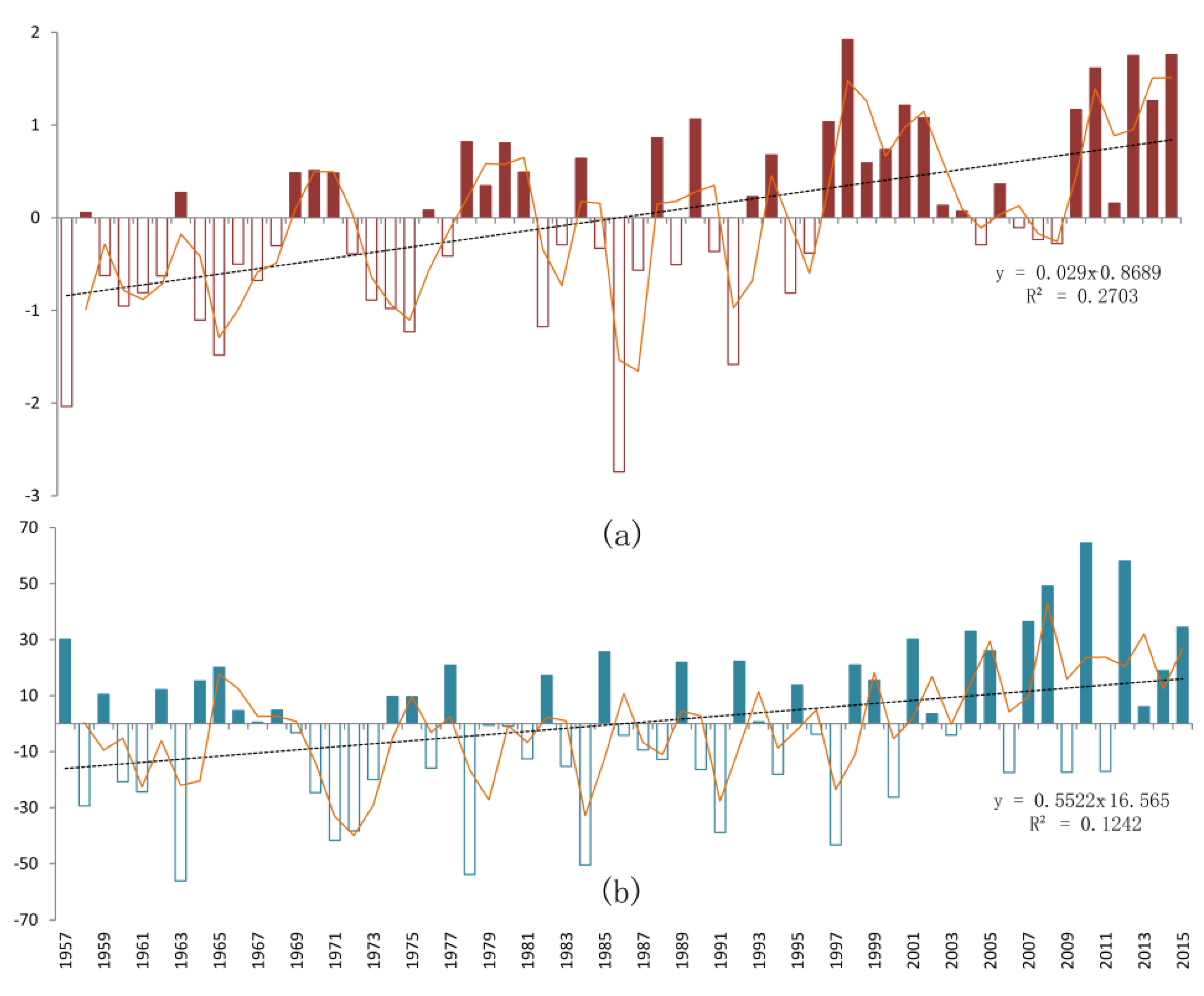


References
- Salick, J.; Byg, A. (Eds.) Indigenous Peoples and Climate Change; A Tyndall Centre Publication. Tyndall Centre for Climate Change Research: Oxford, UK, 2007. [Google Scholar]
- Aryal, S.; Cockfield, G.; Maraseni, T.N. Vulnerability of Himalayan transhumant communities to climate change. Clim. Chang. 2014, 125, 193–208. [Google Scholar] [CrossRef]
- Ford, J.D. Indigenous health and climate change. Am. J. Public Health 2012, 102, 1260–1266. [Google Scholar] [CrossRef] [PubMed]
- Nelson, M.C.; Ingram, S.E.; Dugmore, A.J.; Streeter, R.; Peeples, M.A.; McGovern, T.H.; Hegmon, M.; Arneborg, J.; Kintigh, K.W.; Brewington, S.; et al. Climate challenges, vulnerabilities, and food security. Proc. Natl. Acad. Sci. USA 2016, 113, 298–303. [Google Scholar] [CrossRef] [PubMed]
- Jiri, O.; Mafongoya, P.L.; Mubaya, C.; Mafongoya, O. Seasonal climate prediction and adaptation using indigenous knowledge systems in agriculture systems in southern africa: A Review. J. Agric. Sci. 2016, 8. [Google Scholar] [CrossRef]
- Naah, J.-B.S.N.; Braun, B. Local agro-pastoralists’ perspectives on forage species diversity, habitat distributions, abundance trends and ecological drivers for sustainable livestock production in West Africa. Sci. Rep. 2019, 9. [Google Scholar] [CrossRef] [PubMed]
- Abid, M.; Scheffran, J.; Schneider, U.A.; Ashfaq, M. Farmers’ perceptions of and adaptation strategies to climate change and their determinants: The case of Punjab province, Pakistan. Earth Syst. Dyn. 2015, 6, 225–243. [Google Scholar] [CrossRef]
- Jaakkola, J.J.K.; Juntunen, S.; Näkkäläjärvi, K. The holistic effects of climate change on the culture, well-being, and health of the saami, the only indigenous people in the European Union. Curr. Environ. Health Rep. 2018, 5, 401–417. [Google Scholar] [CrossRef] [PubMed]
- Kronik, J.V.; Verner, D. (Eds.) Chaper 1: Introduction. In Indigenous Peoples and Climate Change in Latin America and the Caribbean; The World Bank: Washington, DC, USA, 2010. [Google Scholar]
- Schick, A.; Sandig, C.; Krause, A.; Hobson, P.R.; Porembski, S.; Ibisch, P.L. People-centered and ecosystem-based knowledge co-production to promote proactive biodiversity conservation and sustainable development in Namibia. Environ. Manag. 2018, 62, 858–876. [Google Scholar] [CrossRef]
- Mugambiwa, S.S. Adaptation measures to sustain indigenous practices and the use of indigenous knowledge systems to adapt to climate change in Mutoko rural district of Zimbabwe. Jàmbá J. Disaster Risk Stud. 2018, 10, 388. [Google Scholar] [CrossRef]
- Mapfumo, P.; Mtambanengwe, F.; Chikowo, R. Building on indigenous knowledge to strengthen the capacity of smallholder farming communities to adapt to climate change and variability in southern Africa. Clim. Dev. 2015, 8, 72–82. [Google Scholar] [CrossRef]
- Hyland, J.J.; Jones, D.L.; Parkhill, K.A.; Barnes, A.P.; Williams, A.P. Farmers’ perceptions of climate change: Identifying types. Agric. Hum. Values 2015, 33, 323–339. [Google Scholar] [CrossRef]
- IPCC. Climate Change: Impacts, Adaptation and Vulnerability; Contribution of working group II to the fourth assessment report of the intergovernmental panel on climate change; Cambridge University Press: Cambridge, UK, 2007. [Google Scholar]
- Ingty, T. High mountain communities and climate change: Adaptation, traditional ecological knowledge, and institutions. Clim. Chang. 2017, 145, 41–55. [Google Scholar] [CrossRef]
- Kupika, O.L.; Gandiwa, E.; Nhamo, G.; Kativu, S. Local ecological knowledge on climate change and ecosystem-based adaptation strategies promote resilience in the middle zambezi biosphere reserve, zimbabwe. Scientifica 2019, 2019, 3069254. [Google Scholar] [CrossRef] [PubMed]
- Reyes-Garcia, V.; Aceituno-Mata, L.; Calvet-Mir, L.; Garnatje, T.; Gomez-Baggethun, E.; Lastra, J.J.; Ontillera, R.; Parada, M.; Rigat, M.; Valles, J.; et al. Resilience of traditional knowledge systems: The case of agricultural knowledge in home gardens of the Iberian Peninsula. Glob. Environ. Chang.-Hum. Policy Dimens. 2014, 24, 223–231. [Google Scholar] [CrossRef]
- Saylor, C.R.; Alsharif, K.A.; Torres, H. The importance of traditional ecological knowledge in agroecological systems in Peru. Int. J. Biodivers. Sci. Ecosyst. Serv. Manag. 2017, 13, 150–161. [Google Scholar] [CrossRef]
- Oteros-Rozas, E.; Ontillera-Sanchez, R.; Sanosa, P.; Gomez-Baggethun, E.; Reyes-Garcia, V.; Gonzalez, J.A. Traditional ecological knowledge among transhumant pastoralists in Mediterranean Spain. Ecol. Soc. 2013, 18. [Google Scholar] [CrossRef]
- Green, D.; Billy, J.; Tapim, A. Indigenous Australians’ knowledge of weather and climate. Clim. Chang. 2010, 100, 337–354. [Google Scholar] [CrossRef]
- Gyasi, E.A.; Awere, K.G. Adaptation to climate change: Lessons from farmer responses to environmental changes in Ghana. In Strategies for Building Resilience against Climate and Ecosystem Changes in Sub-Saharan Africa; Saito, O., KranjacBerisavljevic, G., Takeuchi, K., Gyasi, E.A., Eds.; Springer: Singapore, 2018; pp. 291–312. [Google Scholar]
- Kassam, K.A.; Bulbulshoev, U.; Ruelle, M. Ecology of time: Calendar of the human body in the Pamir Mountains. J. Persianate Stud. 2011, 4, 146–170. [Google Scholar] [CrossRef]
- Khan, S.M.; Page, S.; Ahmad, H.; Harper, D. Ethno-ecological importance of plant biodiversity in mountain ecosystems with special emphasis on indicator species of a Himalayan Valley in the northern Pakistan. Ecol. Indic. 2014, 37, 175–185. [Google Scholar] [CrossRef]
- Castillo, L.; Ladio, A. Mammals and birds as ethno-indicators of change: Their importance to livestock farmers in Arid Patagonia (Argentina). Environ. Dev. Sustain. 2018, 20, 2161–2179. [Google Scholar] [CrossRef]
- Pearce, T.; Ford, J.; Willox, A.C.; Smit, B. Inuit Traditional Ecological Knowledge (TEK), Subsistence Hunting and Adaptation to Climate Change in the Canadian Arctic. Arctic 2015, 68, 233–245. [Google Scholar] [CrossRef]
- Salite, D. Traditional prediction of drought under weather and climate uncertainty: Analyzing the challenges and opportunities for small-scale farmers in Gaza province, southern region of Mozambique. Nat. Hazards 2019. [Google Scholar] [CrossRef]
- Sobral, A.; de los Angeles La Torre-Cuadros, M.; Nobrega Alves, R.R.; Albuquerque, U.P. Conservation efforts based on local ecological knowledge: The role of social variables in identifying environmental indicators. Ecol. Indic. 2017, 81, 171–181. [Google Scholar] [CrossRef]
- Sujakhu, N.M.; Ranjitkar, S.; Niraula, R.R.; Salim, M.A.; Nizami, A.; Schmidt-Vogt, D.; Xu, J. Determinants of livelihood vulnerability in farming communities in two sites in the Asian Highlands. Water Int. 2018, 43, 165–182. [Google Scholar] [CrossRef]
- Hameso, S. Farmers and policy-makers’ perceptions of climate change in Ethiopia. Clim. Dev. 2018, 10, 347–359. [Google Scholar] [CrossRef]
- Kangalawe, R.; Mwakalila, S.; Masolwa, P. Climate change impacts, local knowledge and coping strategies in the Great Ruaha River Catchment Area, Tanzania. Nat. Resour. 2011, 2, 212–223. [Google Scholar] [CrossRef]
- Salick, J.; Ross, N. Traditional peoples and climate change Introduction. Glob. Environ. Chang.-Hum. Policy Dimens. 2009, 19, 137–139. [Google Scholar] [CrossRef]
- Palomo, I. Climate change impacts on ecosystem services in high mountain areas: A literature review. Mt. Res. Dev. 2017, 37, 179–187. [Google Scholar] [CrossRef]
- Dong, S.; Sherman, R. Enhancing the resilience of coupled human and natural systems of alpine rangelands on the Qinghai-Tibetan Plateau. Rangel. J. 2015, 37, I–III. [Google Scholar] [CrossRef]
- Ba, Q.-X.; Lu, D.-J.; Kuo, W.H.-J.; Lai, P.-H. Traditional farming and sustainable development of an indigenous community in the mountain area - a case study of Wutai Village in Taiwan. Sustainability 2018, 10, 3370. [Google Scholar] [CrossRef]
- Wu, N.; Ismail, M.; Joshi, S.; Yi, S.-L.; Shrestha, R.M.; Jasra, A.W. Livelihood diversification as an adaptation approach to change in the pastoral Hindu-Kush Himalayan region. J. Mt. Sci. 2014, 11, 1342–1355. [Google Scholar] [CrossRef]
- Fu, Y.; Grumbine, R.E.; Wilkes, A.; Wang, Y.; Xu, J.-C.; Yang, Y.-P. Climate change adaptation among tibetan pastoralists: Challenges in enhancing local adaptation through policy support. Environ. Manag. 2012, 50, 607–621. [Google Scholar] [CrossRef] [PubMed]
- Schaller, G.B.; Li, H.; Talipu, L.H.; Ren, J.R.; Qiu, M.J.; Wang, H.B. Status of large mammals in the Taxkorgan Reserve, Xinjiang, China. Biol. Conserv. 1987, 42, 53–71. [Google Scholar] [CrossRef]
- Wang, J.; Damerell, P.; Shi, K.; Riordan, P.; Zhu, K.; Wang, X.; Wang, P.; Reheman, A.; Yang, J. Human-wildlife conflict pattern and suggested mitigation strategy in the Pamirs of northwestern China. Rangel. Ecol. Manag. 2019, 72, 210–216. [Google Scholar] [CrossRef]
- SBX. Xinjiang Statistical Yearbook, 1st ed.; Statistical Bureau of Xinjiang Uygur Autonomous Region: Urumqi, China, 2018; pp. 94–95. [Google Scholar]
- Liao, C.; Morreale, S.J.; Kassam, K.-A.S.; Sullivan, P.J.; Fei, D. Following the Green: Coupled pastoral migration and vegetation dynamics in the Altay and Tianshan Mountains of Xinjiang, China. Appl. Geogr. 2014, 46, 61–70. [Google Scholar] [CrossRef]
- Bhagawati, K.; Sen, A.; Kumar Shukla, K. Seasonal calendar and gender disaggregated daily activities of indigenous Galo farmers of eastern Himalayan region of India. Curr. Agric. Res. J. 2017, 5, 325–330. [Google Scholar] [CrossRef]
- Ram, H.; Gupta, N.; Saini, J.S. Accumulated growing degree-day requirements and yield ability of irrigated durum wheat as influenced by sowing time. Agric. Res. J. 2016, 53, 303–306. [Google Scholar] [CrossRef]
- Seefeldt, S.S.; Kidwell, K.K.; Waller, J.E. Base growth temperatures, germination rates and growth response of contemporary spring wheat (Triticum aestivum L.) cultivars from the US Pacific Northwest. Field Crops Res. 2002, 75, 47–52. [Google Scholar] [CrossRef]
- Juskiw, P.E.; Jame, Y.W.; Kryzanowski, L. Phenological development of spring barley in a short-season growing area. Agron. J. 2003, 95, 1633. [Google Scholar] [CrossRef]
- Lloyd-Hughes, B.; Saunders, M.A. A drought climatology for Europe. Int. J. Climatol. 2002, 22, 1571–1592. [Google Scholar] [CrossRef]
- Kim, K.; Wang, M.-C.; Ranjitkar, S.; Liu, S.-H.; Xu, J.-C.; Zomer, R.J. Using leaf area index (LAI) to assess vegetation response to drought in Yunnan province of China. J. Mt. Sci. 2017, 14, 1863–1872. [Google Scholar] [CrossRef]
- Zuma-Netshiukhwi, G.; Stigter, K.; Walker, S. Use of traditional weather/climate knowledge by farmers in the south-western free state of South Africa: Agrometeorological learning by scientists. Atmosphere 2013, 4, 383–410. [Google Scholar] [CrossRef]
- Clarke, P.A. Australian aboriginal ethnometeorology and seasonal calendars. Hist. Anthr. 2009, 20, 79–106. [Google Scholar] [CrossRef]
- David-Chavez, D.M.; Gavin, M.C. A global assessment of Indigenous community engagement in climate research. Environ. Res. Lett. 2018, 13, 123005. [Google Scholar] [CrossRef]
- Turner, N.J.; Clifton, H. “It’s so different today”: Climate change and indigenous lifeways in British Columbia, Canada. Glob. Environ. Chang. 2009, 19, 180–190. [Google Scholar] [CrossRef]
- Reyes-Garcia, V.; Fernandez-Llamazares, A.; Gueze, M.; Garces, A.; Mallo, M.; Vila-Gomez, M.; Vilaseca, M. Local indicators of climate change: The potential contribution of local knowledge to climate research. Wiley Interdiscip. Rev. Clim. Chang. 2016, 7, 109–124. [Google Scholar] [CrossRef]
- Kreutzmann, H. Pamir or pamirs: Perceptions and interpretations. In Mapping transition in the Pamirs; Herrmann, K., Teiji, W., Eds.; Springer: Cham, Switzerland, 2016; pp. 17–40. [Google Scholar]
- Kikvidze, Z.; Tevzadze, G. Loss of traditional knowledge aggravates wolf-human conflict in Georgia (Caucasus) in the wake of socio-economic change. Ambio 2015, 44, 452–457. [Google Scholar] [CrossRef]
- Moyo, B.; Dube, S.; Lesoli, M.; Masika, P.J. Communal area grazing strategies: Institutions and traditional practices. Afr. J. Range Forage Sci. 2008, 25, 47–54. [Google Scholar] [CrossRef]
- Negi, V.S.; Maikhuri, R.K.; Pharswan, D.; Thakur, S.; Dhyani, P.P. Climate change impact in the Western Himalaya: People’s perception and adaptive strategies. J. Mt. Sci. 2017, 14, 403–416. [Google Scholar] [CrossRef]
- Madhav Karki, P.P.; Jay, R.A. Climate change: Integrating indigenous and local knowledge into adaptation policies and practices: A case study from Nepal. In Shifting Cultivation Policies: Balancing Environmental and Social Sustainability; Cairns, M., Ed.; CABI: Oxfordshire, UK, 2017. [Google Scholar]
- Sujakhu, N.M.; Ranjitkar, S.; Niraula, R.R.; Pokharel, B.K.; Schmidt-Vogt, D.; Xu, J. Farmers’ perceptions of and adaptations to changing climate in the melamchi valley of nepal. Mt. Res. Dev. 2016, 36, 15–30. [Google Scholar] [CrossRef]
- Meyer, R.S.; Purugganan, M.D. Evolution of crop species: Genetics of domestication and diversification. Nat. Rev. Genet. 2013, 14, 840–852. [Google Scholar] [CrossRef] [PubMed]
- Chen, Y.H.; Shapiro, L.R.; Benrey, B.; Cibrián-Jaramillo, A. Back to the origin: In situ studies are needed to understand selection during crop diversification. Front. Ecol. Evolut. 2017, 5. [Google Scholar] [CrossRef]
- Skarbo, K.; VanderMolen, K. Maize migration: Key crop expands to higher altitudes under climate change in the Andes. Clim. Dev. 2016, 8, 245–255. [Google Scholar] [CrossRef]
- D’Alpoim Guedes, J.A.; Lu, H.; Hein, A.M.; Schmidt, A.H. Early evidence for the use of wheat and barley as staple crops on the margins of the Tibetan Plateau. Proc. Natl. Acad. Sci. USA 2015, 112, 5625–5630. [Google Scholar] [CrossRef] [PubMed]
- SBX. Xinjiang Statistical Yearbook, 1st ed.; Statistical Bureau of Xinjiang Uygur Autonomous Region: Urumqi, China, 2004; p. 321. [Google Scholar]
- Akkari, C.; Bryant, C.R. The co-construction approach as approach to developing adaptation strategies in the face of climate change and variability: A conceptual framework. Agric. Res. 2016, 5, 162–173. [Google Scholar] [CrossRef]
- O’Connor, M.; Prober, S. A Calendar of Ngadju Seasonal Knowledge. A Report to Ngadju Community and Working Group; CSIRO Sustainable Ecosystems: Floreat, WA, USA, 2010; p. 3. [Google Scholar]
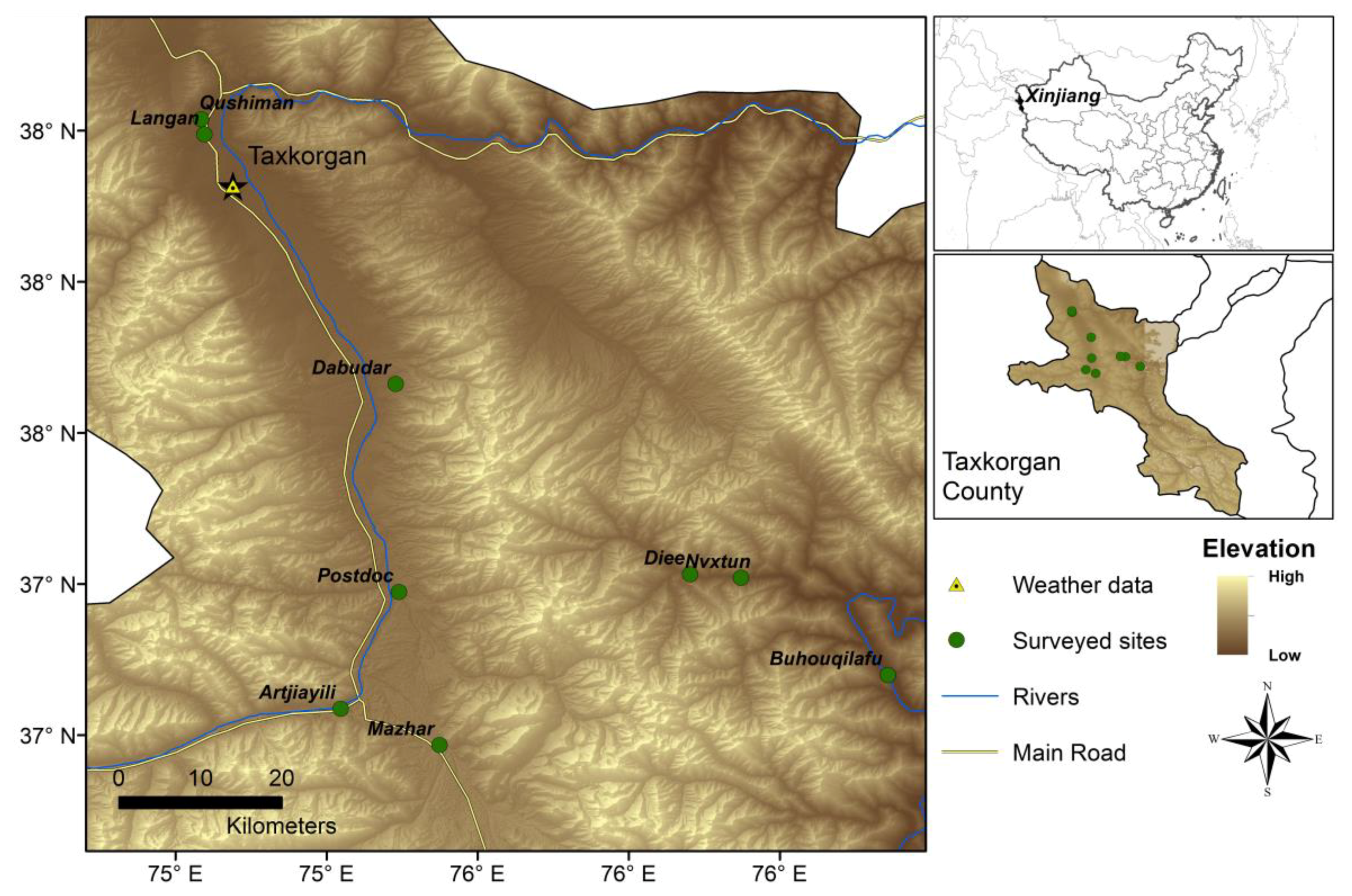
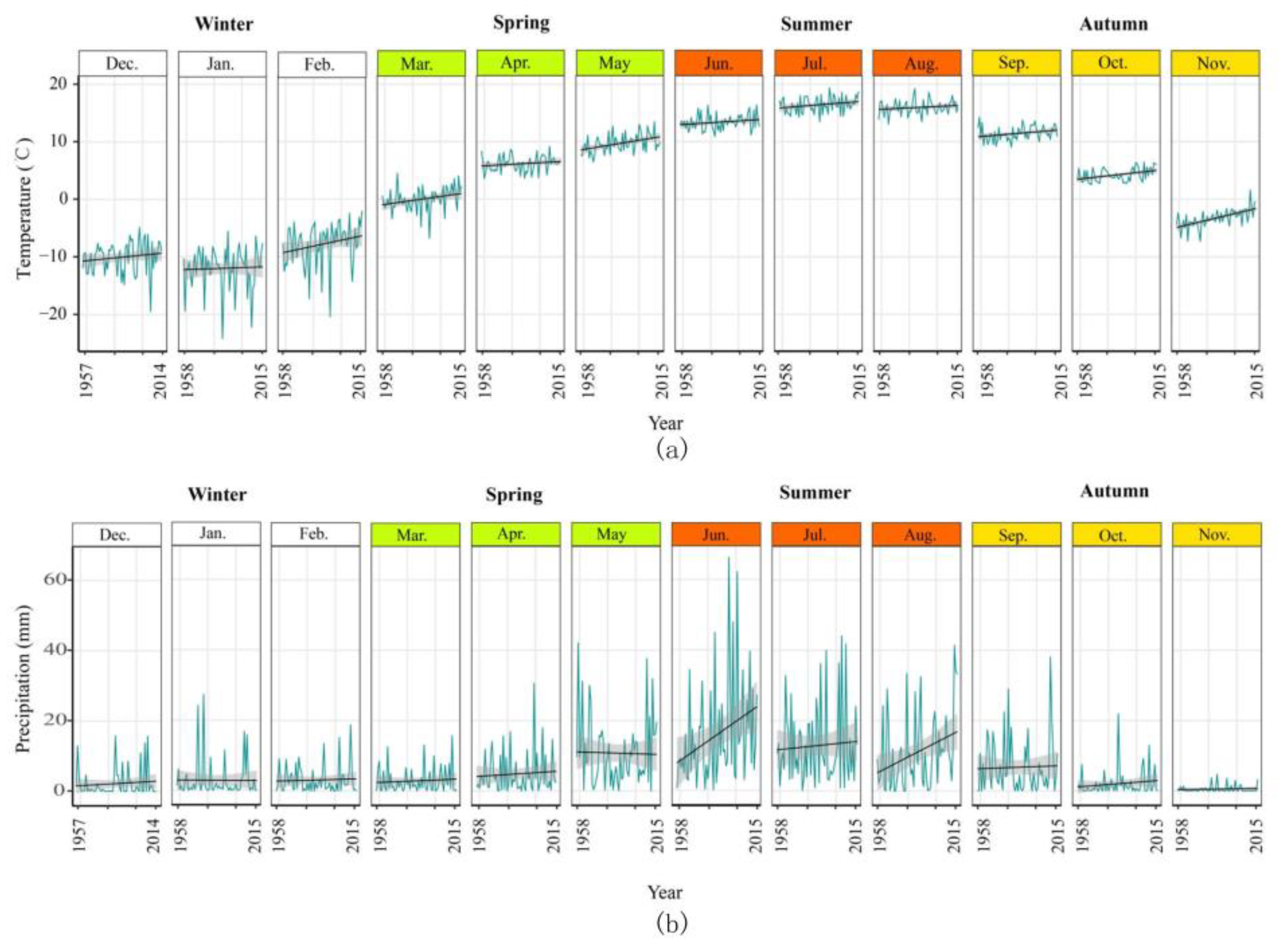


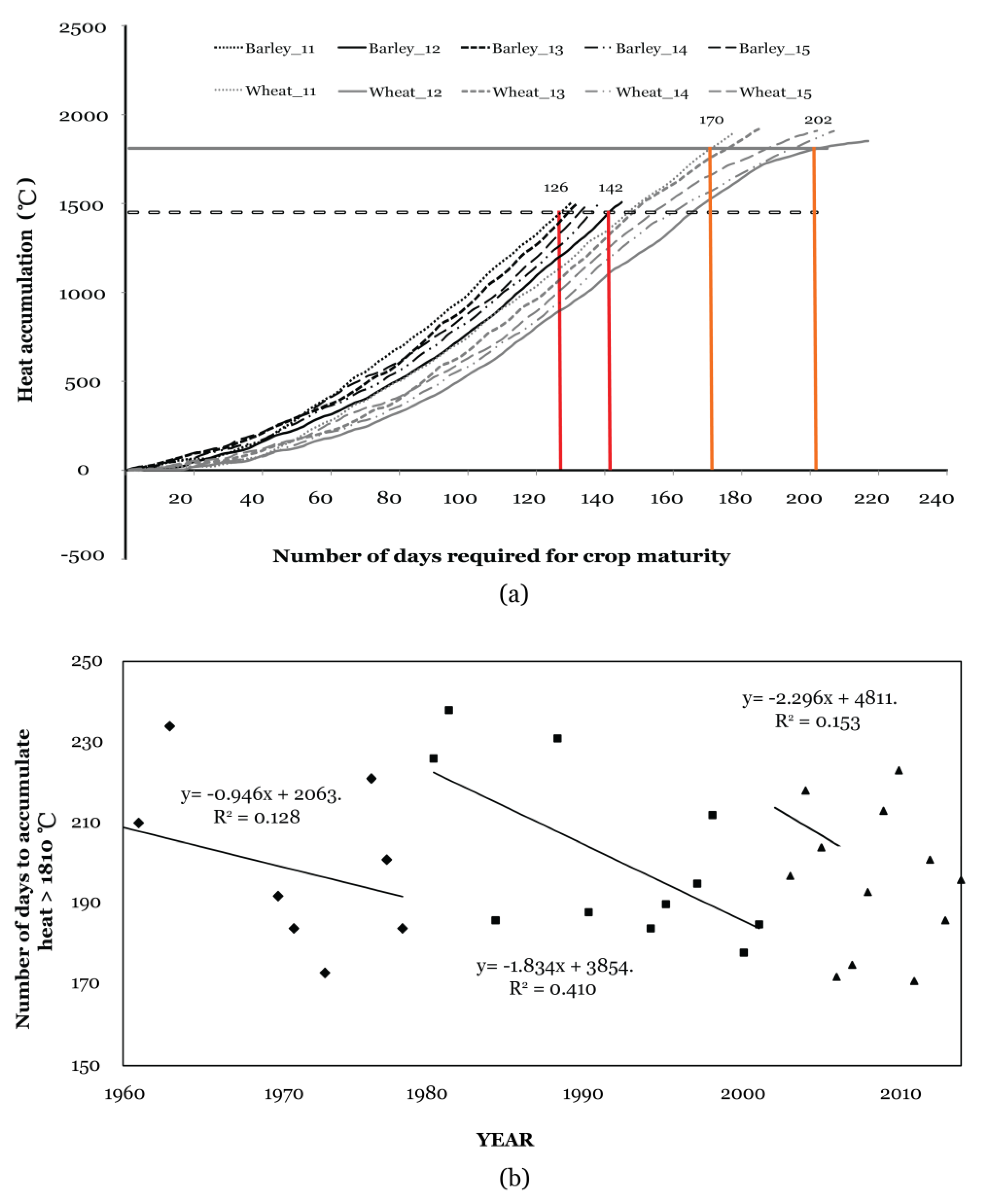
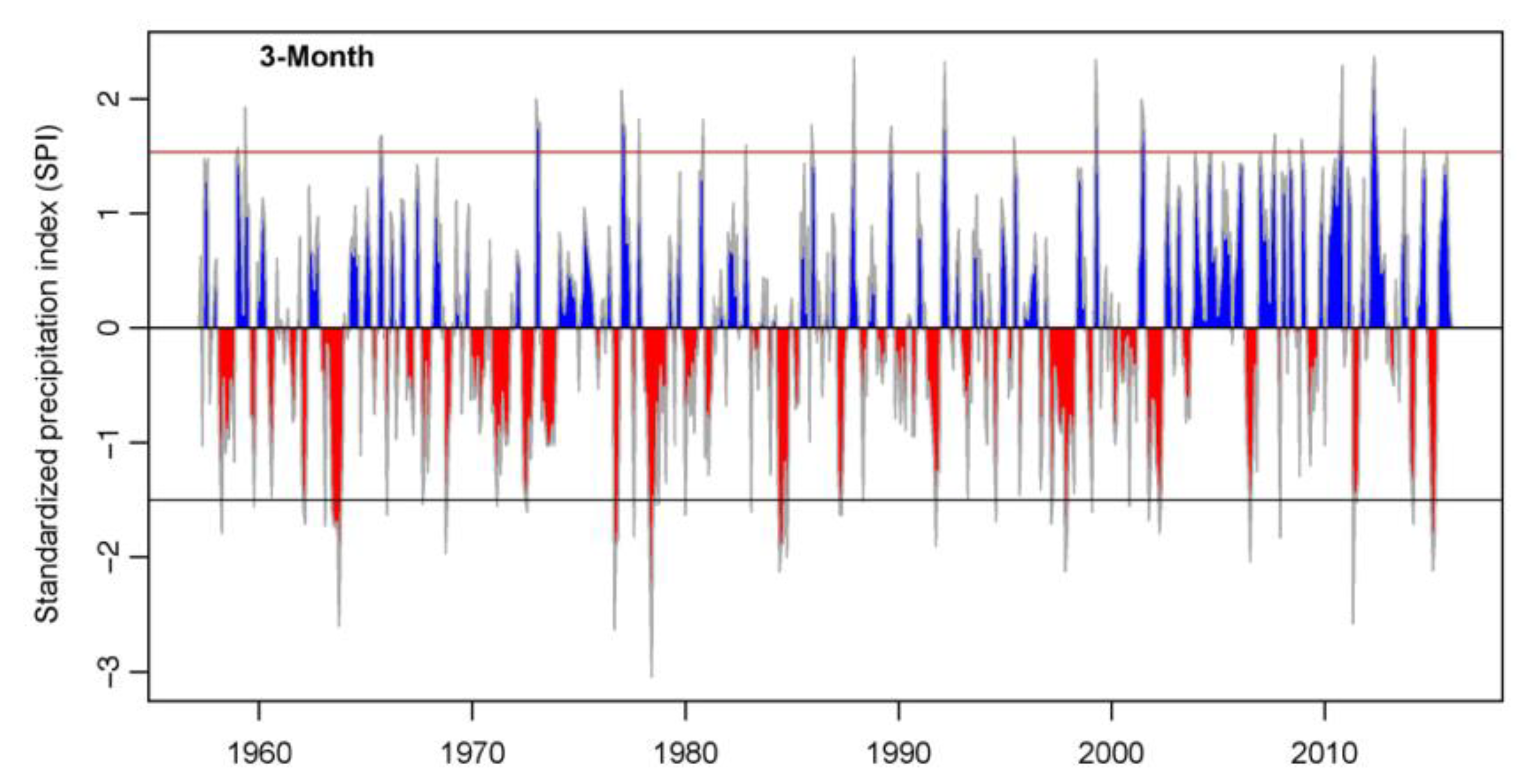
| Community (Village) | Municipality (Township) | Elevation (m) | Longitude (E) | Latitude (N) | Main Ethnic Minority |
|---|---|---|---|---|---|
| Buhouqilafu | Maryoung | 2467 | 75.9525 | 37.2328 | Tajik |
| Nvxtun | Maryoung | 2882 | 75.7904 | 37.34 | Tajik |
| Diee | Maryoung | 3066 | 75.7343 | 37.3439 | Tajik |
| Langan | Tizinafu | 3034 | 75.1985 | 37.8293 | Tajik |
| Qushiman | Tizinafu | 3092 | 75.1949 | 37.846 | Tajik |
| Postdoc | Dabudar | 3395 | 75.4131 | 37.3244 | Tajik |
| Dabudar | Dabudar | 3436 | 75.4096 | 37.5539 | Tajik |
| Artjiayili | Dabudar | 3582 | 75.3489 | 37.1956 | Kirgiz |
| Mazhar | - | 3670 | 75.4579 | 37.1557 | Tajik |
| SPI Values | Wet | SPI Values | Drought |
|---|---|---|---|
| 2.0 or more | Extremely wet | −2.0 or less | Extreme drought |
| 1.5 to1.99 | Severely wet | −1.5 to −1.99 | Severe drought |
| 1.0 to 1.49 | Moderately wet | −1.0 to −1.49 | Moderate drought |
| 0 to 0.99 | Mildly wet | 0 to −0.99 | Mild drought |
| Season | Observations | Indicator | Specific Activities | Linked-Category | Purpose | Remarks |
|---|---|---|---|---|---|---|
| Early-Spring | Snow begin melting from low elevation sites | Geo: Snow | Season-identification | Preparations | ||
| Early-Spring | Frozen rivers begin to melt | Hydro: water | ||||
| Early-Spring | Grass near hot springs first begin to grow | Bio: Grass | ||||
| Early-Spring | Leaf buds turn to green and unfold | Bio: Populus alba, Elaeagnus, Angustifolia, Prunus armeniaca L., Tamarix ramosissima, Juglans regia | ||||
| Early-Spring | Lands turns soft | Geo: # Lands | Force a spade into the land to check the suitability for tilling the land. | Farming | Food | |
| Early-Spring | Festival (~21 March) | Socio: # YinshuiJie | Repair and dig canals | Farming | Food | Different timing at lower and higher sites |
| Mid-Spring | Prunus armeniaca L. blooms | Bio:Prunus armeniaca L. | at lower elevation sites | |||
| Mid-Spring | Arriving: Motacilla alba | Bio: # Motacilla alba | Tilling and prepare for cultivation and sowing | Farming | Food | |
| Mid-Spring | Marmota wake up from hibernation | Bio: # Marmota | ||||
| Mid-Spring | Arriving: Motacilla alba | Bio: # Motacilla alba | Begin with yoghourt-making | Food | ||
| Mid-Spring | Snowmelt to thin layer | Geo: # Snow | Move and station in spring pastures | Livestock | Fodder | If there is heavy snowfall in winter, the rangeland will be in good condition |
| Mid-Spring | Quantity and height of grass (1–2 knuckle width) | Bio: # Grass | ||||
| Late-Spring | Perception of weather: Warming condition | # Atmospheric | ||||
| Late-Spring | Taraxacum flowering, the earliest flowering plant | Bio: # Taraxacum | Preparation for moving to summer pastures | Livestock | Fodder | |
| Early-Summer | Perception of weather: Becomes hot gradually | Atmospheric | Season-identification | Preparations | More flood and rainfall in recent years | |
| Early-Summer | Snow area on top of the mountain decreases | Geo: Snow | ||||
| Early-Summer | Perception of weather: Hot | # Atmospheric | Move and station in summer pastures | Livestock | Fodder | Move ahead of time if no snowfall in winter in their villages |
| Early-Summer | Snow melts completely in summer pastures | Geo: # Snow | ||||
| Early-Summer | Water volume increase in rivers and seasonal rivulets reappeared | Hydro: # Water | ||||
| Early-Summer | Good conditions and height of grass (3–5 fingers) | Bio: # Grass | ||||
| Early-Summer | Water level rise and turbid in major rivers | Geo: # Water | ||||
| Mid-Summer | Prunus armeniaca L ripen | Bio: Prunus armeniaca | Season-identification | at lower elevation sites | ||
| Mid-Summer | Arriving: Motacilla citreola | Bio: # Motacilla citreola | Begin with butter-making | Food | ||
| Mid-Summer | Greening and flowering: Seriphidium | Bio: # Seriphidium (* Kalabaduo) | Collect plants and make oil for protecting from UV when grazing. | Livestock | Cosmetic | Use of it is declining. |
| Mid-Summer | Timing of flowering and dropping: Ceratoidescompacta | Bio: # Ceratoidescompacta | Collect Ceratoidescompacta and dry in the sun as in to fuel | Livestock | Firewood | |
| Late-Summer | Timing of flowering and dropping: Oxytropis DC and Astragalus L. | Bio: # Oxytropis DC; # Astragalus L. | Guide livestock when flowering to gain weight; protect livestock from where these two species grow when dropping to avoid abdominal distension. | Livestock | Fodder | |
| Late-Summer | Timing of flowering and fruit: Medicinal plants | Bio: # Saussurea glacialis Herd. (* Xuelian), # Pleurospermum Hoffm. (* Kulumuti) | Collect materials of medicinal plants from high elevation sites | Livestock | Medicine | After collecting, they move down |
| Early-Autumn | Leaves on the tree turn to yellow and orange (e.g., Populus alba L), dropping leaves | Bio: Populus alba L | Season-identification | Preparation | ||
| Early-Autumn | Conditions of grass: Maximum height attained, and begin weathering | Bio: # Grass | Fodder collection | Livestock | Fodder | |
| Early-Autumn | Grass at the summer pasture is completely consumed; | Bio: # Grass | Prepare and move to autumn pasture | Livestock | Fodder | |
| Early-Autumn | Perception of weather: Getting cool | # Atmospheric | ||||
| Early-Autumn | Snowfall begins on summer pasture | Geo: # Snow | ||||
| Early-Autumn | Water in valleys gradually disappear and water volume in the river decreases gradually | Hydro: # Water | ||||
| Early-Autumn | Various birds appear in croplands | Bio: Motacilla alba Motacilla citreola Upupa epops Tetraogallus | Prepare and begin with harvest | Farming | Food | |
| Early-Autumn | Crops get ripe | Bio: Crops | ||||
| Late-Autumn | Migratory birds have emigrated | Bio: # Migratory birds | Move back to villages or winter pastures Keep livestock in livestock-shed | Livestock | Fodder | Wild-animal (Panthera uncial, Ursidae, Canislupus) attack occur frequently in settlements and routes at higher elevations |
| Late-Autumn | Ursidae and Marmota start hibernation | Bio: # Ursidae, # Marmota | ||||
| Early-Winter | Perception of weather: Getting cold | # Atmospheric | ||||
| Early-Winter | Seasonal rivulets disappear; Water canals freeze | Hydro: Water | Season-identification | Preparation | Winter season has gotten warmer in recent years. | |
| Late-Winter | Ovis aries and Capra aegagrus hircus give birth in February | Bio: Ovis aries, Capra aegagrus hircus | Take care of newborn livestock | Livestock |
© 2019 by the authors. Licensee MDPI, Basel, Switzerland. This article is an open access article distributed under the terms and conditions of the Creative Commons Attribution (CC BY) license (http://creativecommons.org/licenses/by/4.0/).
Share and Cite
Yang, H.; Ranjitkar, S.; Zhai, D.; Zhong, M.; Goldberg, S.D.; Salim, M.A.; Wang, Z.; Jiang, Y.; Xu, J. Role of Traditional Ecological Knowledge and Seasonal Calendars in the Context of Climate Change: A Case Study from China. Sustainability 2019, 11, 3243. https://doi.org/10.3390/su11123243
Yang H, Ranjitkar S, Zhai D, Zhong M, Goldberg SD, Salim MA, Wang Z, Jiang Y, Xu J. Role of Traditional Ecological Knowledge and Seasonal Calendars in the Context of Climate Change: A Case Study from China. Sustainability. 2019; 11(12):3243. https://doi.org/10.3390/su11123243
Chicago/Turabian StyleYang, Huizhao, Sailesh Ranjitkar, Deli Zhai, Micai Zhong, Stefanie Daniela Goldberg, Muhammad Asad Salim, Zhenghong Wang, Yi Jiang, and Jianchu Xu. 2019. "Role of Traditional Ecological Knowledge and Seasonal Calendars in the Context of Climate Change: A Case Study from China" Sustainability 11, no. 12: 3243. https://doi.org/10.3390/su11123243
APA StyleYang, H., Ranjitkar, S., Zhai, D., Zhong, M., Goldberg, S. D., Salim, M. A., Wang, Z., Jiang, Y., & Xu, J. (2019). Role of Traditional Ecological Knowledge and Seasonal Calendars in the Context of Climate Change: A Case Study from China. Sustainability, 11(12), 3243. https://doi.org/10.3390/su11123243





